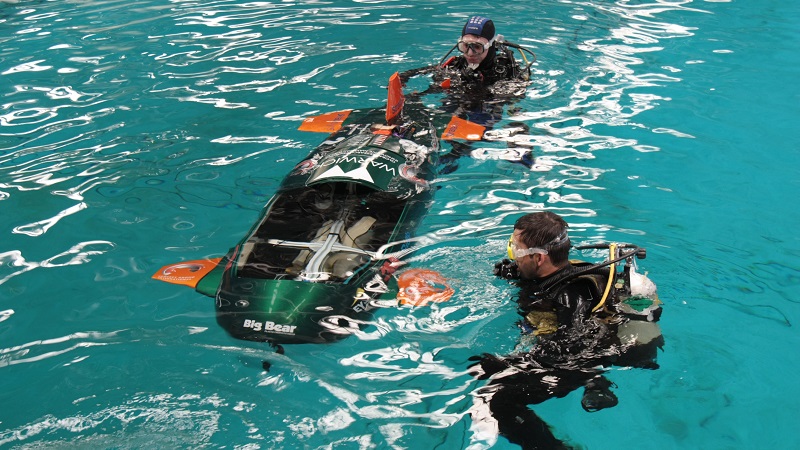The European International Submarine Race (eISR) is organised by the Institute for Marine Engineering, Science and Technology (IMarEST), backed by volunteers and hosted by QinetiQ at its Ocean Basin testing facility.
The basin is 122m by 61m and 5.5m deep. Entrants are tasked with designing, building and racing a human-powered sub. The engineering challenge tests teamwork, imposes financial constraints and requires teams to demonstrate innovation.
The competition was won by team Taniwha 2, from the University of Auckland, New Zealand.
The University of Warwick team’s craft, Godiva 2, received the award for ‘Best Design Report’.
Meet HPS-Godiva2
Ian Tuersley, a Chartered Engineer with the Institution, was the team's Project Director. Institution Student Affiliate member and mechanical engineering student, Josh Dobson, was the Project Leader for the University of Warwick team.
Josh said: “The project is foremost for us, an academic project which consists of 25% of our final grade. It is therefore important we perform not only in the results/competition phase, but also in design and project management. Having said that, the project requires us to manufacture a pioneering, innovative craft, which hence requires us to function almost as an entire engineering and manufacturing company.
“We must work with suppliers and customers, and communicate our vision and requirements. We must also maintain good sponsor relations, promote ourselves and, of course, finance the project. All these extra challenges reflect how industry delivers projects, and presents a brilliantly intriguing project prospect in getting to grips with the skills needed across these functions.
“It was great actually assembling and manufacturing the submarine. Making and building is not something we often do during our engineering course, and it's great to see how our designs work, or do not work, in the flesh.”

Although due to visitor restrictions at the QinetiQ site, it was not possible for the public to come to the races, the organisers made sure there was an opportunity to showcase the teams’ achievements and promote rewarding careers that engineering can offer.
The race days were preceded by a free public open day at Hilsea Lido, where the teams’ vessels were on display and families were able to ask questions about their work.
Josh commented: “The event at Hilsea Lido was great for demonstrating the different approaches that teams from around the world have taken in delivering on the human-powered submarine brief. The public were very receptive to the work of the students, and I hope it's an event that can only grow in the future.”versity of Warwick's Project Leader anber, Josh Dobson
Professor William Megill, Race Director of eISR 2016 and Professor of Bionics at Rhine Waal University, explained the strengths of the winning team and its submarine, Taniwha 2, from the University of Auckland, New Zealand.
He said: “They proved that the combination of innovation and attention to detail make all the difference. Their biomimetic craft was driven to impressive, near record-breaking speeds, by a robust biomimetic propulsion system and a novel fish-inspired hydrodynamically efficient tail which replaced the rudder usually found on submarines.”
He congratulated all the participants, which included runners up, Technical University of Delft with Wasub VI, which achieved 7.3 knots to clinch the fastest speed award.
“This year, of the 18 teams which began the competition in September, 11 managed to qualify for the racing events. This involved meeting a rigorous set of technical and performance requirements which had to be documented in written, photographic and videographic formats.
“Over 140 students demonstrated their passion for engineering and teamwork as they honed the performance of their own craft and helped each other to overcome the individual challenges that arose. It was fabulous to experience the really positive spirit which arose from amongst these gifted young people.”
Third place University of Washington delivered, in its submarine What Sub Dawg, an impressive machine, which only missed the top spot by the slimmest of margins. Careful engineering design, coupled with extensive testing, design optimisation and pilot training produced the highest speed by a female pilot (4.6 knots).
University of Bath and its sub, Salacia, also made it to Gosport. Salacia, which suffered damage during the week, was awarded ‘Best Repair 2016’ in the winners table.
Read about The European International Submarine Race (eISR).